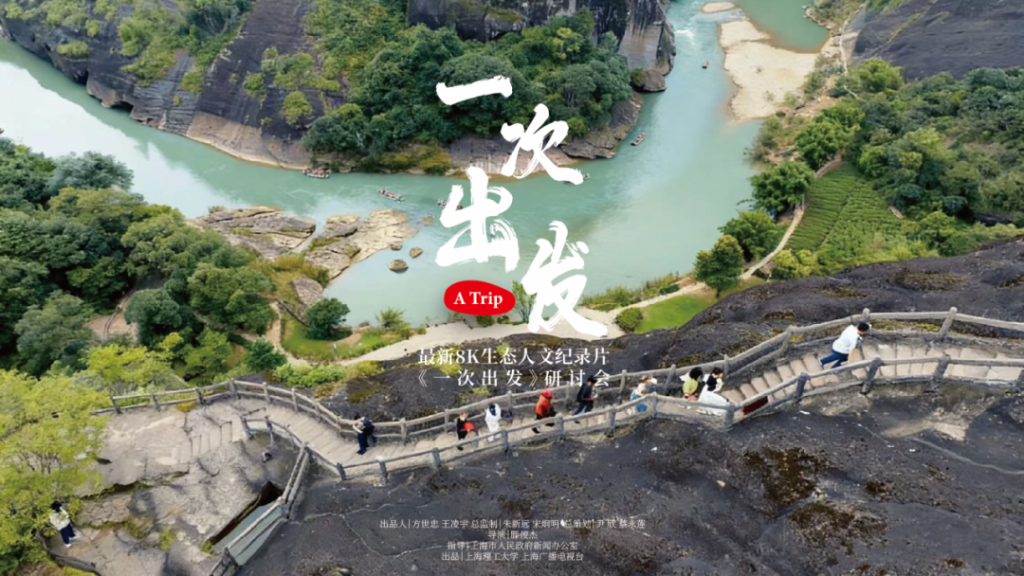
“To record Xinjiang, one must understand the sources of its waters, the momentum of its flows, and the direction of its currents; only then can we continue to weave the cultural gene through the transitions of time.” On the morning of October 8, during the premiere ceremony for the documentary "Yarkand River," chief director Liu Liting discussed the creative philosophy behind the work.
To celebrate the 75th anniversary of the founding of New China, the large-scale 4K natural and cultural documentary "Yarkand River," produced by Shanghai Radio and Television Station, began airing on October 8 during Oriental TV's "New Documentary" segment. The film has been included in the State Administration of Radio and Television's key documentary planning for the 14th Five-Year Plan, the "Documenting the New Era" project, and is a major initiative under Shanghai's cultural and ethnic engagement agenda.

Poster for "Yarkand River"
As an important outcome of advancing the Cultural Engagement in Xinjiang initiative, "Yarkand River" centers on solidifying the consciousness of a common Chinese national identity. Utilizing 4K ultra-high-definition technology, it deeply explores the natural landscape, historical culture, and modern development of the Yarkand River basin, narrating the stories of interactions and integration among diverse ethnicities to portray an open, inclusive, and harmonious yet diverse image of Xinjiang.
From the 2012 work "Four Chapters of Kashgar" to the 2016 "Legends of Kashgar," and now to "Yarkand River," this documentary team has consistently focused on and recorded the vibrant changes in Kashgar. They aim to highlight the intertwining of ancient traditions and modern rhythms along both banks of the Yarkand River, showcasing the dual themes of preservation and development, and interpreting the deep love and attachment the people of Xinjiang have for their homeland. This reinforces the consciousness of a shared community among the Chinese nation while displaying enduring cultural confidence and the pulse of our times.

Still from "Yarkand River"
Through meticulous cinematography, the past, present, and future of Kashgar in Xinjiang unfold sequentially—During the spring equinox, Tajik people along the banks of the Yarkand River celebrate the ancient traditional festival "Shogun Bakharl," welcoming the arrival of spring; villagers from Altash Village in Shache County witness the completion of Xinjiang's largest water conservancy project, the Altash Water Conservancy Hub; the cotton industry in Bachu County flourishes, with young cotton farmers achieving success through mechanized farming…
According to chief director Liu Liting, behind the lens is the three-year, tireless dedication and persistence of the production team. Three filming crews documented the region through more than twenty expeditions, covering snow-capped mountains, glaciers, plateaus, canyons, pastures, oases, desert steppes, and deserts. Their total travel distance exceeded 150,000 kilometers, resulting in over 1,000 hours of precious footage.

Still from "Yarkand River"
The documentary "Yarkand River" vividly decodes the cultural confidence of the Xinjiang region and represents an impressive demonstration of the integration of ultra-high-definition and AIGC technology in documentary filmmaking.
The entire production process employed 4K ultra-high-definition filming methods. In addition to traditional digital cameras and professional film-grade drones, special equipment such as racing drones, panoramic cameras, and GoPro devices were utilized, creating a stylish, textured, and thought-provoking visual feast for the audience.
In post-production, the team employed 3D special effects and virtual engines to reconstruct the Mogao Caves in Dunhuang, developed geographical maps of the Yarkand River basin, and created climate evolution models for the region. They also constructed a virtual exhibition hall for cultural relics, utilizing holographic projections to showcase precious artifacts looted by Western "explorers," allowing viewers to transcend time and space limitations to witness these lost treasures.

Still from "Yarkand River"
The documentary also utilizes AIGC technology to restore precious archival footage of the Kashgar region from a century ago in 4K ultra-high-definition, bringing back the legendary tales of historical figures such as Ban Chao and Zhang Qian. At the beginning of the film, this technology is utilized to prominently showcase the iconic landscapes and cultural features of the Yarkand River basin, offering viewers an immersive journey through history.
Beyond the documentary itself, the creation team for "Yarkand River" has also embarked on new thoughts and explorations regarding the expansion of the industry chain.
The film engaged young composer Gong Tianpeng to design the theme music and collaborated with the Shanghai Philharmonic Orchestra to record this music—approximately 80 musicians were gathered together to create distinctive configurations for each segment of the film's score.
Notably, this premiere ceremony introduced a new format featuring orchestral accompaniment, creating an interactive immersive experience combining visual and auditory elements. Reports indicate that the main creative team plans to hold an audiovisual symphonic concert for "Yarkand River," allowing more audience members to experience the touching classical melodies from the film live and feel the fusion and harmony of diverse cultures.
Furthermore, the "Yarkand River" creative team also plans to collaborate with leading companies in the tourism industry to explore a profound fusion model between culture and tourism, jointly developing tourism routes centered around the Yarkand River to inject new vitality into local cultural and tourism industries.

Still from "Yarkand River"
Fang Shizhong, Deputy Director of the Municipal Publicity Department and Party Secretary, Director, and Editor-in-Chief of Shanghai Radio and Television Station (Shanghai Media Group), stated that currently, Shanghai Radio and Television Station is implementing the overarching strategy to position Shanghai as the best practice site for Xi Jinping's cultural thoughts. They are fully executing the core strategy of "news-led station, culture-promoted station, and integration-empowered station," striving to advance systemic reforms within mainstream media. During this reform process, they highly value the creation and dissemination of quality documentaries by Shanghai Radio and Television Station, especially supporting Shanghai Radio and Television Station's Authentic Media Co., Ltd. to enhance international perspectives, strengthen industry benchmarks, and focus on improving artistic originality and market operation capabilities. They aim to continually transition from past "broadcast services" to future "communication services," developing and releasing more high-quality documentaries that resonate with the audience on subjects like cultural history, natural geography, social realities, and mutual learning among civilizations, while striving to become a highland for the creation of documentaries embodying Chinese aesthetics and humanistic qualities. Additionally, they will comprehensively implement an "open door policy for satellite channels and programming across the entire station," enhancing the quality of the main channel of Oriental Television and the primary platform of Look East. Particularly, they will introduce a brand new "New Documentary" segment on Oriental Television, aiming to satisfy the new demands of national audiences and local citizens for high-quality documentary public viewing services through stronger communication platforms, better program offerings, and more considerate integrated dissemination strategies.


